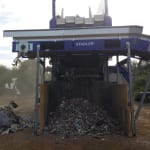
Landfill sites can give rise to different risks. In particular, older sites predating the introduction of government regulations, which tend to be filled with municipal solid waste and lack modern landfill technology, will soon require costly remediation measures to avoid future environmental and health problems. In Europe, there are between 150,000 and 500,000 landfill sites, of which an estimated 90% are “non sanitary” landfills predating the EU Landfill Directive of 1999. Enhanced Landfill Mining (ELFM) has the potential of providing a solution that could dramatically reduce future remediation costs and reclaim valuable land while unlocking precious resources.
The four-year New-Mine research project, led by KU Leuven Institute for Sustainable Metals and Minerals SIM2, was launched in 2016 to look into different aspects of Enhanced Landfill Mining. Its aim is to develop and integrate cutting-edge, eco-friendly ELFM technologies to valorize Europe’s landfills, recovering resources such as materials, energy and land, while mitigating future environmental and health risks and avoiding significant remediation costs.
Dr. Lieven Machiels, Science & Technology Coordinator of the project at the KU Leuven Institute for Sustainable Metals and Minerals, explains: “We consider Enhanced Landfill Mining the missing link to a Circular Economy. The Circular Economy Action Plan of the European Green deal focuses on a “sustainable products” policy that prioritizes reducing and reusing materials before actually recycling them, moving up the Waste Hierarchy. Nevertheless, what is not yet addressed is the question of what Europe and other countries in the world will do with the vast amounts of industrial and consumer waste that have been disposed of in waste dumps and landfills over the past 100 years. In this context, ELFM has been proposed as an out-of-the-box approach to address how we can deal with the waste of the past, irrespective of the urgent need to avoid new waste creation and disposal in the future.”
The project has received funding from the European Union's EU Framework Programme for Research and Innovation Horizon 2020 and involves eight European universities as well as Stadler and other companies from the private sector. Fifteen PhD students have been tasked with researching new technologies and testing them in four technical work packages that follow a value chain approach. From “Innovative landfill exploration and mechanical processing”, to “Solar/Plasma/Hybrid thermochemical conversion” and “Advanced upcycling”. The fourth work package applies multi-criteria assessment methods to compare combined resource-recovery/remediation, that is ELFM, with the “Do-nothing’, “Classic remediation”, and “Classic landfill mining with (co-incineration)” approaches.
Dr. Lieven Machiels explains: “In classic Landfill Mining, the focus is on reducing the volume of waste, for example through incineration and the recovery of land, while the production of recyclates is in general limited. In the New-Mine project, we followed an ELFM approach aiming at a maximal recovery of resources. Instead of burning the light fraction, we produce a Refuse Derived Fuel (RDF), which is thermally converted to produce a synthetic gas and a vitrified residue. The syngas can be further upcycled to produce methane or hydrogen, while the vitrified residue can be used for producing cement and construction materials.”
Mechanical processing technologies to recover resources from waste
RWTH Aachen University, one of the project’s partners, invited Stadler to participate, contributing its expertise and equipment. The company played an important role in the first work package, dedicated to mechanical processing. The main goal was to identify ways of improving the quality of the fractions in order to produce RDF, which has a variety of applications. Another important goal was to research uses for fine fraction, which accounts for more than 50% of the waste in landfill mining, and currently has no utilization. The project showed that further mechanical separation of fine fraction can produce sand for use as an aggregate in the construction sector. The light fraction can also be used in a thermo-valorization process.
Stadler also contributed to the Training Programme associated to the project with a course on “Automated sorting technology for complex waste”, which was held during the second New-Mine Network Event for the fifteen participating PhD researchers.


